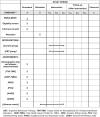Effectiveness of cognitive behavioral therapy on kinesiophobia and oral health-related quality of life in patients with temporomandibular disorders, study protocol for a randomized controlled trial
- PMID: 33217860
- PMCID: PMC7676583
- DOI: 10.1097/MD.0000000000023295
Effectiveness of cognitive behavioral therapy on kinesiophobia and oral health-related quality of life in patients with temporomandibular disorders, study protocol for a randomized controlled trial
Abstract
Background: Temporomandibular disorders (TMD) is a common physical and psychological disease in dental department. Pain and mandibular limitation are the main reasons for patients to seek oral treatment. However, the presence of kinesiophobia, patients often catastrophize pain, so as to avoid mandibular movement, which seriously affects their quality of life. Cognitive behavioral therapy (CBT) has significant improvements in reducing kinesiophobia and quality of life in musculoskeletal disease, but has not been proved in TMD patients. The study aims to apply CBT on kinesiophobia and oral health related quality of life (OHRQOL) in TMD patients.
Methods: A total of 108 individuals between 18 and 65 years of age, who will be referred to the temporomandibular joint clinic of Stomatology Hospital of Tianjin Medical University in china will be randomized into 2 treatment arms. The control group will receive a conventional treatment, whereas the experiment group will receive CBT on the basis of the control group. The primary outcomes will be the kinesiophobia and OHRQOL, and will be measured by the Tampa scale for kinesiophobia for patients with Temporomandibular Disorders (TSK-TMD) and the Oral Health Impact Scale for patients with temporomandibular disorders (OHIP-TMDs), the secondary outcomes will be pain intensity measured by Numerical Rating Scale (NRS), pain catastrophizing measured by Pain Catastrophizing Scale (PCS), anxiety and depression measured by Hospital Anxiety and Depression Scale (HADS), and self-efficacy measured by General Self-Efficacy Scale (GSES).
Discussion: This study protocol reported a randomized controlled trial which aimed at assessing the effectiveness of the CBT versus conventional treatment with TMD.
Trial registration: Registered in the Chinese Clinical Trial Registration Center with the number ChiCTR2000038573. Registered 24 September 2020.
Conflict of interest statement
The authors have no conflicts of interest.
Figures
Similar articles
-
Does a Program Based on Cognitive Behavioral Therapy Affect Kinesiophobia in Patients Following Total Knee Arthroplasty? A Randomized, Controlled Trial With a 6-Month Follow-Up.J Arthroplasty. 2018 Mar;33(3):704-710. doi: 10.1016/j.arth.2017.10.035. Epub 2017 Oct 28. J Arthroplasty. 2018. PMID: 29239772 Clinical Trial.
-
The effectiveness of conservative interventions on temporomandibular disorder-related kinesiophobia and pain catastrophizing: a systematic review.Musculoskelet Sci Pract. 2025 Jun;77:103328. doi: 10.1016/j.msksp.2025.103328. Epub 2025 Apr 8. Musculoskelet Sci Pract. 2025. PMID: 40233599
-
Effectiveness of a multicomponent treatment versus conventional treatment in patients with fibromyalgia: Study protocol.Medicine (Baltimore). 2020 Jan;99(4):e18833. doi: 10.1097/MD.0000000000018833. Medicine (Baltimore). 2020. PMID: 31977878 Free PMC article.
-
Characteristics of painful temporomandibular disorders and their influence on jaw functional limitation and oral health-related quality of life.J Oral Rehabil. 2024 Sep;51(9):1748-1758. doi: 10.1111/joor.13768. Epub 2024 Jun 6. J Oral Rehabil. 2024. PMID: 38845181
-
The effects of kinesiophobia on outcome following total knee replacement: a systematic review.Arch Orthop Trauma Surg. 2020 Dec;140(12):2057-2070. doi: 10.1007/s00402-020-03582-5. Epub 2020 Aug 24. Arch Orthop Trauma Surg. 2020. PMID: 32839826
Cited by
-
The Relationship between Kinesiophobia, Emotional State, Functional State and Chronic Pain in Subjects with/without Temporomandibular Disorders.J Clin Med. 2024 Feb 1;13(3):848. doi: 10.3390/jcm13030848. J Clin Med. 2024. PMID: 38337542 Free PMC article.
-
Evaluating the Impact of Various Treatment Modalities on the Chewing Efficiency of Anterior Disc Displacements of Temporomandibular Joint Disorder Cases: A Comparative Study.J Int Soc Prev Community Dent. 2024 Apr 29;14(2):136-143. doi: 10.4103/jispcd.jispcd_151_23. eCollection 2024 Mar-Apr. J Int Soc Prev Community Dent. 2024. PMID: 38827358 Free PMC article.
-
Temporomandibular disorders and mental health: shared etiologies and treatment approaches.J Headache Pain. 2025 Mar 12;26(1):52. doi: 10.1186/s10194-025-01985-6. J Headache Pain. 2025. PMID: 40075300 Free PMC article. Review.
-
Efficacy of Cognitive Behavioral Therapy for Kinesiophobia: A Systematic Review and Meta-Analysis of Randomized Controlled Trials.J Pain Res. 2025 Aug 6;18:3919-3932. doi: 10.2147/JPR.S526179. eCollection 2025. J Pain Res. 2025. PMID: 40791870 Free PMC article. Review.
References
-
- LeResche L. Epidemiology of temporomandibular disorders: implications for the investigation of etiologic factors. Crit Rev Oral Biol Med 1997;8:291–305. - PubMed
-
- Wu N, Hirsch C. Temporomandibular disorders in German and Chinese adolescents. J Orofac Orthop 2010;71:187–98. - PubMed
-
- Yu-meng D, Min-Kui F, Urban H. Prevalence of temporomandibular joint dysfunction (TMJD) in Chinese children and adolescents. A cross-sectional epidemiological study. Eur J Orthod 1995;305–9. - PubMed
-
- de Godoi Gonçalves DA, Dal Fabbro AL, Campos JADB, et al. Symptoms of temporomandibular disorders in the population: an epidemiological study. J Orofac Pain 2010;24: - PubMed
-
- Gil-Martínez A, Navarro-Fernández G, Mangas-Guijarro M, et al. Comparison Between Chronic Migraine and Temporomandibular Disorders in Pain-Related Disability and Fear-Avoidance Behaviors. Pain Med (Malden, Mass) 2017;18:2214–23. - PubMed
Publication types
MeSH terms
LinkOut - more resources
Full Text Sources
Medical



